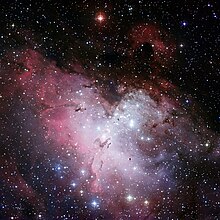Eagle Nebula
| Emission nebula | |
|---|---|
| H II region | |

Three-colour composite mosaic image of the Eagle Nebula. Credit: ESO
|
|
| Observation data: J2000.0 epoch | |
| Right ascension | 18h 18m 48s |
| Declination | −13° 49′ |
| Distance | 7,000 ly |
| Apparent magnitude (V) | +6.0 |
| Apparent dimensions (V) | 7.0 arcmins |
| Constellation | Serpens |
| Physical characteristics | |
| Radius | 70×55 (cluster 15) ly |
| Absolute magnitude (V) | -8.21 |
| Notable features | 1–2 million years old |
| Designations | Messier 16, NGC 6611,Sharpless 49, RCW 165, Gum 83, Star Queen Nebula |
The Eagle Nebula (catalogued as Messier 16 or M16, and as NGC 6611, and also known as the Star Queen Nebula and The Spire) is a young open cluster of stars in the constellation Serpens, discovered by Jean-Philippe de Chéseaux in 1745–46. Both the "Eagle" and the "Star Queen" refer to visual impressions of the dark silhouette near the center of the nebula, an area made famous as the "Pillars of Creation" photographed by the Hubble Space Telescope. The nebula contains several active star-forming gas and dust regions, including the Pillars of Creation.
The Eagle Nebula is part of a diffuse emission nebula, or H II region, which is catalogued as IC 4703. This region of active current star formation is about 7000 light-years distant. A spire of gas that can be seen coming off the nebula in the northeastern part is approximately 9.5 light-years or about 90 trillion kilometers long.
The cluster associated with the nebula has approximately 8100 stars, which are mostly concentrated in a gap in the molecular cloud to the north-west of the Pillars. The brightest star (HD 168076) has an apparent magnitude of +8.24, easily visible with good binoculars. It is actually a binary star formed of an O3.5V star plus an O7.5V companion. This star has a mass of roughly 80 solar masses, and a luminosity up to 1 million times that of the Sun. The cluster's age has been estimated to be 1–2 million years.
...
Wikipedia
